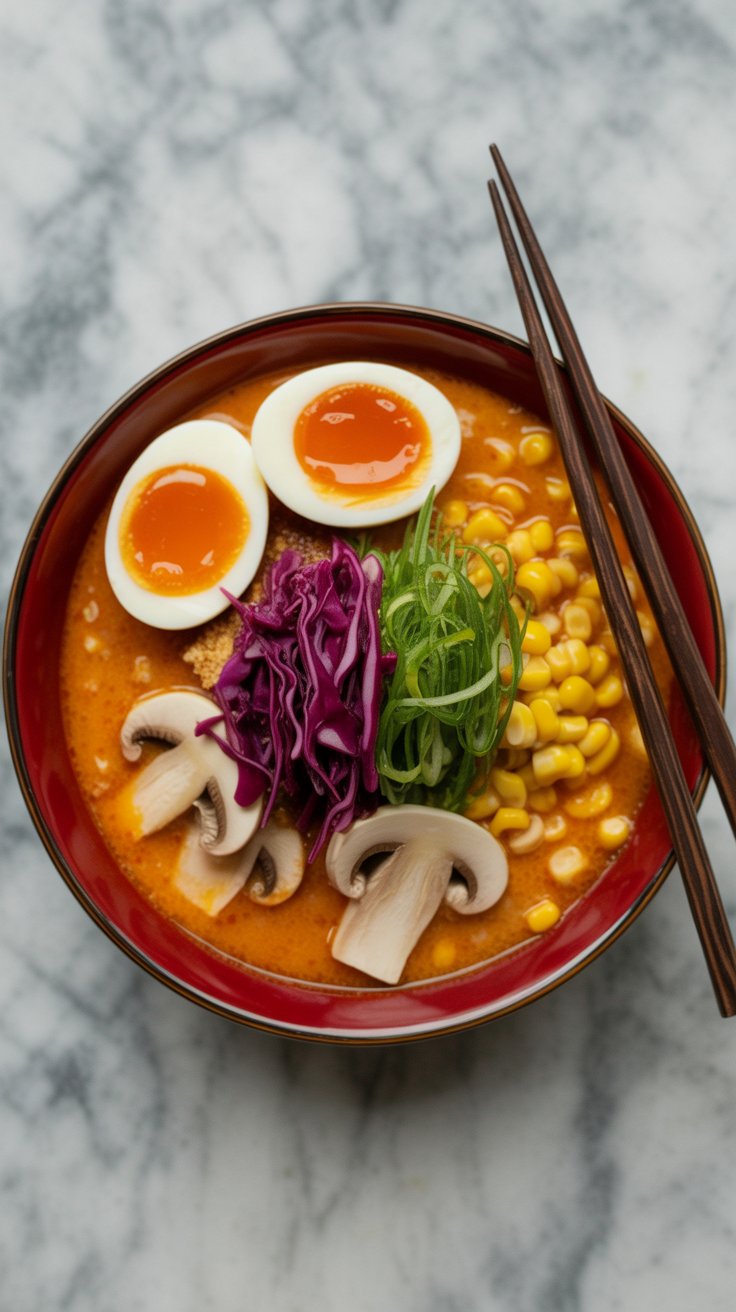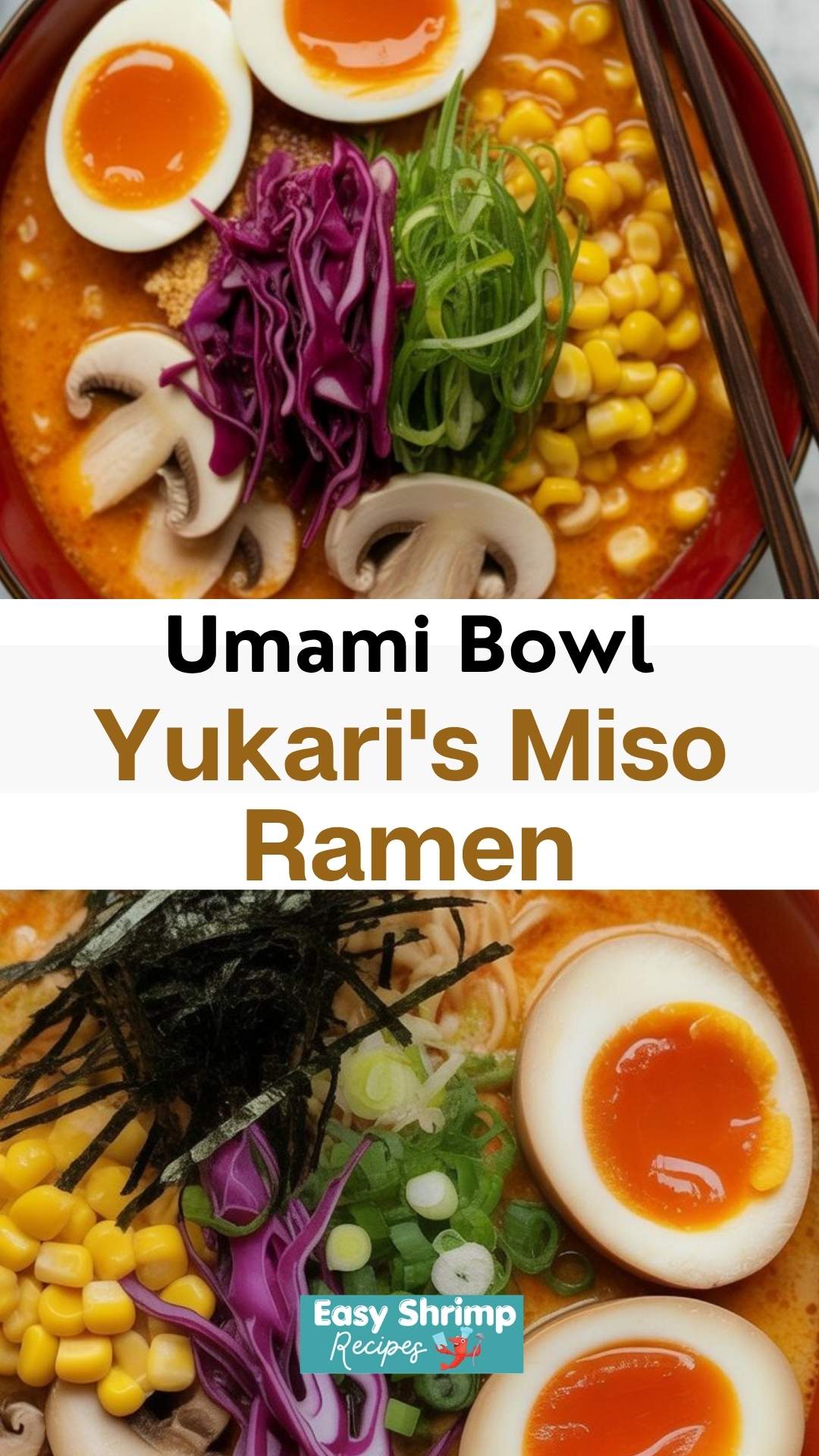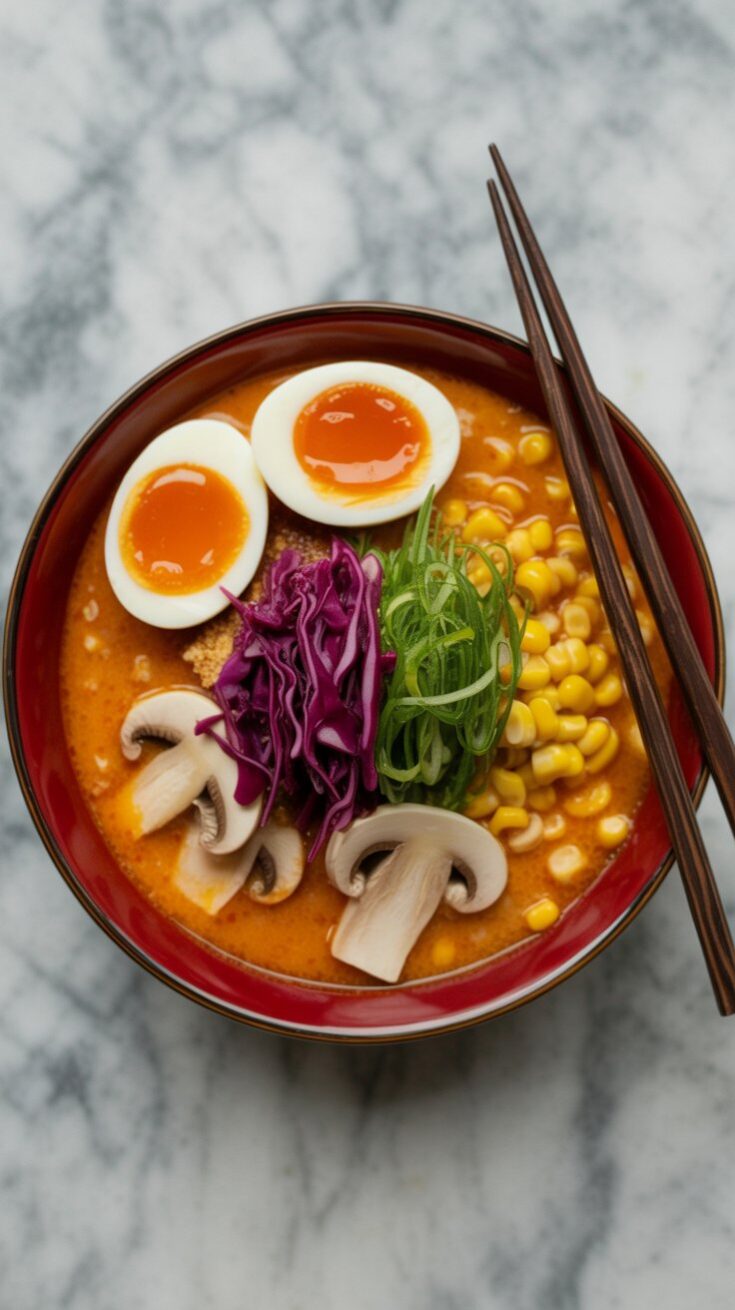Every time I make Yukari’s Miso Ramen, I’m reminded of a small kitchen in Kyoto where my partner and I spent an afternoon learning how to make ramen from scratch. It was during our honeymoon — and though I’ve had plenty of ramen before, there was something so special about making it with Yukari, surrounded by the smell of miso and simmering broth.

Her original recipe involved a long 24-hour soak for the dashi and a blend of three different misos. But back at home, I needed a version that fit into a busy weeknight without losing that soul-soothing flavor. So this is my shortcut version — fast to make, but still layered with that deep miso umami.
Why This Ramen Recipe Works So Well
This isn’t a complicated restaurant-style ramen that needs hours of simmering. It’s approachable, satisfying, and full of warmth. The miso paste gives the broth its signature depth, and the little noodle hack Yukari shared with us is a game changer:
Boil regular pasta with baking soda and salt, and it transforms — springier, bouncier, and more ramen-like than you’d expect. It’s the kind of trick that makes you feel like you know a little kitchen magic.
Ingredients You’ll Need
-
Miso paste – White miso works beautifully here for a mellow, balanced flavor.
-
Vegetable broth – Or homemade dashi if you want a more traditional base.
-
Soy sauce – Adds saltiness and depth.
-
Sesame oil – A small drizzle gives that signature aroma.
-
Garlic and ginger – Freshly minced for brightness and heat.
-
Noodles – Regular pasta cooked with baking soda and salt, or fresh ramen noodles if available.
-
Toppings – I like soft-boiled eggs, corn, sliced green onions, nori strips, sautéed mushrooms, and sometimes a little chili oil.
Yukari taught us that toppings are where you can truly make ramen your own. Some nights I keep it simple, other nights it turns into a loaded bowl with everything but the kitchen sink.

Step-by-Step Cooking Method
-
Cook the noodles: Boil pasta in water with baking soda and salt. This gives it that signature chewy ramen texture. Drain and set aside.
-
Sauté the aromatics: In a pot, warm sesame oil and gently cook garlic and ginger until fragrant.
-
Make the broth: Stir in miso paste and soy sauce. Gradually whisk in the vegetable broth until smooth. Let it simmer gently for 5–10 minutes to let the flavors meld.
-
Assemble the bowl: Divide noodles into bowls. Pour the hot broth over the top.
-
Top it off: Add your favorite toppings — soft-boiled eggs, corn, mushrooms, nori, scallions, or chili oil.
When the steam hits your face as you lean in for the first slurp, it’s like being transported right back to that cozy Kyoto kitchen.
Real-Life Tips That Make It Easier
-
Prep toppings in advance. It makes the whole process feel smooth and relaxed. I usually soft-boil the eggs and chop the vegetables while the broth simmers.
-
Don’t boil the miso. Add it gently and keep the heat low to preserve its flavor and nutrients.
-
Taste as you go. Miso pastes can vary in saltiness, so adjust the soy sauce accordingly.
-
Keep the noodles slightly firm. They’ll soften a bit in the hot broth.
I’ve made this recipe on both slow Sunday afternoons and rushed Wednesday nights. Either way, it never loses its comforting, layered flavor.
Toppings That Work Beautifully
Here are some of my favorites — but mix and match to make it your own:
-
Soft-boiled eggs – with jammy centers.
-
Sautéed shiitake mushrooms – for extra umami.
-
Sweet corn – adds brightness.
-
Nori sheets – for that classic ramen touch.
-
Scallions – fresh and crisp.
-
Tofu cubes – if you want to make it heartier.
-
Chili oil – for a hint of heat.
Storing and Reheating
Miso ramen is best enjoyed fresh, but if you have leftovers, store the broth and noodles separately. The noodles can get mushy if left in the broth overnight. Reheat the broth on low heat (don’t boil), and pour it over freshly warmed noodles. Toppings like eggs and vegetables can be added right before serving.

FAQs
Can I use different types of miso?
Yes, red or blended miso adds a deeper, bolder flavor. White miso is lighter and slightly sweet.
Can I use regular ramen noodles instead of pasta?
Absolutely. The baking soda trick is just for when ramen noodles aren’t on hand.
How can I make it spicy?
Add chili oil, sriracha, or even a little gochujang into the broth for some heat.
Can I make this ahead?
You can make the broth a day in advance and keep it in the fridge. Reheat gently when ready to serve.
Is this recipe vegetarian?
Yes, as long as you use vegetable broth or kombu-based dashi and skip meat toppings.
Yukari's Miso Ramen

Rich, savory, and deeply comforting — this Miso Ramen brings together silky noodles, a creamy miso-cashew broth, and customizable toppings.
Ingredients
For the Broth:
- 1 tablespoon grated ginger
- 2 garlic cloves, finely chopped or grated
- 1 bunch scallions (white/light green parts finely chopped, dark green thinly sliced)
- ¼ cup + 2 tablespoons mellow white miso paste, divided
- 3 tablespoons tomato paste
- 1 tablespoon gochujang or other chili paste
- 8 cups water, divided
- 4 dried shiitake mushrooms (optional)
- ½ cup raw cashews, soaked overnight or quick soaked
- 1 tablespoon soy sauce or tamari
- 1 teaspoon sugar or honey
For the Noodles:
- 8 oz thin spaghetti or angel hair pasta
- 4 quarts water
- 2 tablespoons baking soda
- 2 teaspoons kosher salt
Topping Ideas:
- Thinly sliced or grated carrots or cabbage
- Sliced mushrooms (use the soaked shiitakes if using)
- Corn kernels
- Green sprouts or extra scallions
- Boiled eggs or baked tofu
- Thinly sliced meat
- Nori strips
- Chili oil
Instructions
- Bring 4 quarts of water to a boil in a large pot. Add baking soda (the water will foam), salt, and pasta. Cook for 2 minutes longer than package directions, stirring to prevent overflow. Drain and rinse briefly. The noodles will turn yellow and slightly springy, resembling fresh ramen. Divide among bowls.
- In a large pot, warm 2 tablespoons of oil over medium heat. Add ginger, garlic, and the white parts of the scallions. Cook for about 1 minute, stirring frequently, until fragrant but not browned.Stir in 2 tablespoons miso paste, tomato paste, and gochujang. Cook for 3–4 minutes, stirring often, until the tomato paste darkens and begins to caramelize on the bottom of the pot.
- Pour in 4 cups of water and add the shiitake mushrooms if using. Scrape the bottom of the pot to release any bits of flavor. Bring to a boil, then reduce to a low simmer for 10 minutes.Remove the mushrooms, squeeze out excess liquid back into the pot, slice them (discard woody stems), and set aside as a topping.
- Blend soaked cashews with the remaining 4 cups of water until smooth and creamy. Pour this cashew mixture into the pot and bring back to a gentle simmer.Dissolve the remaining ¼ cup miso paste in a ladle of hot broth, then stir it into the pot. Turn off the heat and add soy sauce and sugar. Taste and adjust seasoning as needed.
- If using fresh veggies like carrots, cabbage, or mushrooms, give them a quick sauté until lightly softened. This adds flavor and keeps them vibrant.
- Place noodles in each bowl. Ladle the hot miso broth over top. Add toppings of your choice — such as soft-boiled eggs, scallions, mushrooms, tofu, or nori — and finish with a drizzle of chili oil if desired. Serve immediately.
Notes
- If you prefer a milder flavor, reduce the chili paste or omit it entirely.
- Gochujang adds a subtle heat and deep umami but can be replaced with sriracha or your favorite chili paste.
- Dried shiitake mushrooms boost the umami depth of the broth — but the recipe works without them.
- The baking soda trick gives regular spaghetti that classic ramen noodle chewiness.
Nutrition Information
Yield
4Serving Size
1Amount Per Serving Calories 552Total Fat 22gSaturated Fat 4gTrans Fat 0gUnsaturated Fat 15gCholesterol 73mgSodium 4069mgCarbohydrates 66gFiber 6gSugar 19gProtein 28g
Easy Shrimp Recipes.com, occasionally offers nutritional information for recipes contained on this site. This information is provided as a courtesy and is an estimate only. This information comes from online calculators. Although allchickenrecipes.com attempts to provide accurate nutritional information, these figures are only estimates.
Final Thought
This Miso Ramen isn’t just a bowl of soup — it’s a reminder of warm travel memories and a testament to how simple ingredients can come together to create something comforting.
Yukari’s little tricks changed how I make ramen at home. Every time I ladle the steaming broth over those springy noodles, it feels like sharing a piece of that Kyoto experience. Perfect for a chilly night, or whenever your soul needs a little warmth in a bowl.

